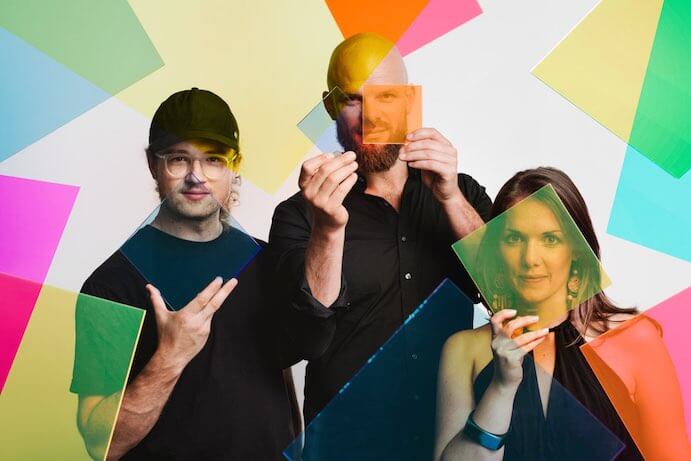A Line that Terminates at the Present, Maria Finkelmeier’s debut album as a composer, skillfully weaves together her talent as an improviser with her technical prowess as a percussionist into a lively narrative. Finkelmeier’s works blend elements of her classical roots with ambient pop textures and bursts of high-energy, jazz-like melodic lines. Collaborators such as the Kadence Ensemble and MASARY Studios complement Finkelmeier’s style, setting up rhythmic patterns and fluid textures which showcase Finkelmeier’s virtuosity. A Line that Terminates at the Present gives way to Finkelmeier’s creative voice depicting an immense enjoyment for her craft, utilizing simple yet effective techniques to keep material moving forward.
The album begins in collaboration with the Kadence Ensemble on Without Voices and To Know No. These quartets set the standard for the album, immediately putting forth the clearest depiction of Finkelmeier’s style. Without Voices quickly settles into a groove, displaying the ensemble’s maturity–through the edgy shifts in material, the group drives the work forward with incredible precision. The intrigue of the work never lets up, and continual augmentations to the subdivision of the patterns are strikingly cheeky, opting for the unease of a wandering beat. While the harmonic and melodic material remains fairly static, the placement of said elements on a constantly shifting platform seem jarring at times. This unsettled and fluid nature captivates the listener, though the ease at which the ensemble remains tattooed to the beat would never imply uncertainty from the performance.
To Know No, a commission from the Boston Center for the Arts, dissects the emotion one feels when hearing the word no. One of the many voices says about the word no, “The reaction to no differs, changes. Mutations happen.” This is not only reflective of the reaction to the word but could also be applied to the composition itself. The highly repetitive and driving nature of the material lends itself well to a structure which slowly sheds itself to make room for creative spoken depictions of the word “no.” Numerous aspects of the word “no” from our current social lexicon appear and are beautifully orchestrated to invoke the feeling of the word, rather than its explicit origins. The cascading melodic lines create a haunting effect, a residue of previous instantiations lingering as the work progresses. The insight displayed by Finkelmeier in To Know No prodigiously integrates concept to form, bringing the greatest impact to the word “no.”

The atmospheric quality of Insomia Suite stands in contrast to the high intensity and pulsive works that precede it. Finkelmeier brilliantly captures the setting of night as gentle textures create a timeless soundscape. The use of electronics elegantly complements the still aura while cultivating the imagery of blending a dreamworld with the conscious state.
The title work, A Line that Terminates at the Present, exemplifies Finkelmeier’s musical interests, but is executed with mixed results. Finkelmeier’s exuberant performance showcases masterful technique and off-kilter grooves to create an intricate harmonic and rhythmic structure, but is overshadowed by technical deficiencies in saxophonist Tim Hall’s performance. While the melodic content is well structured, issues with intonation and precision fall short of matching the complexity and finesse Finkelmeier sets as the standard.
Finkelmeier and MASARY Studios co-founder Ryan Edwards collaborated to produce the album’s final two tracks, Come with Me and The Solution. Come with Me display the same techniques to augment harmonic structures and displace the beat, though it does not display the dexterity of works such as Without Voices. The work lacks the subtle complexities that intensify others. The melodic structure frames the text with clarity, though the orchestration choice of mirroring wispy vocals with glockenspiel creates an unintended dissonance, removing it from the general texture.

The Solution ends the album strong, returning to the constantly shifting and complex patterns boasted in earlier works. Finkelmeier and Edwards find their chemistry here, locking into the elaborate tapestry of underlying subdivisions while allowing their mastery to provide the subtle force propelling the work. Finkelmeier strips The Solution of many of the flamboyant gestures previously displayed, allowing her to display her simple yet keen manipulations progressing harmonic and melodic content.
A Line that Terminates at the Present is a clear window into Finkelmeier’s voice as both a composer and performer. Finkelmeier’s heavy influences as an improviser are apparent and allow her dexterity and incredible fluency to shine while navigating constantly shifting and uneven ground. While the album does not display a wide variety of style, the difference between the highly rhythmic and ambient works create a well-rounded experience. Maria Finkelmeier’s adept performance leaves a mark–she has found her voice in the new music world and is damned good at making it known.
























